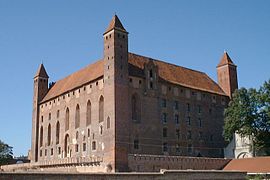This is an old revision of this page, as edited by DePortau (talk | contribs) at 09:45, 7 January 2007 (added info box, links). The present address (URL) is a permanent link to this revision, which may differ significantly from the current revision.
Revision as of 09:45, 7 January 2007 by DePortau (talk | contribs) (added info box, links)(diff) ← Previous revision | Latest revision (diff) | Newer revision → (diff)
Gniew (Kashubian: Gniéw, Template:Lang-de) is a town situated on the left bank of the Vistula River, in the Pomeranian Voivodeship, Poland. It is located at around 53°49′60″N 18°49′60″E / 53.83333°N 18.83333°E / 53.83333; 18.83333 Coordinates: latitude seconds >= 60
Coordinates: longitude seconds >= 60
{{#coordinates:}}: invalid latitude.
History
The first recorded mentions of Gniew appear in written documents from the first half of the 13th century, one of which refers to the region as Terra Gymeu. The earliest name for the settlement was Gmiew, however, during the Middle Ages the name Wońsk was also used. The German name of Mewe for the town is still reflected on the coat of arms of the city, which bears the presence of a seagull.
Beginning in the 10th century, the region belonged to the Polan tribe and was part of Gdańsk Pomerania. After the division of Poland by Bolesław Krzywousty, Gniew fell to the castellany of Starogard Gdański. The land later fell to the Princes of Świecie and in 1229 Prince Sambor and Świętopełk granted it to the Cistercian abbey in Oliwa. In the second half of the 13th century, Sambor retook Gniew from the Cistercians and in 1276 bestowed it on the Teutonic Knights. Their claim was formally recognized by Mściwój II in 1282, and the city became the first stronghold of the Teutonic Order on the left riverside of the Vistula. A castle was built as a result of this important strategic location, and in 1297 the Teutonic Knights gave Gniew town privileges.
The city exchanged hands various times between 1410-1466 until it became a part of Poland following the Peace of Toruń in 1466. In 1626, during the Swedish-Polish War, a battle between the Polish-Lithuanian Commonwealth and Swedish forces was fought in the area of Gniew, resulting in a victory for the army of Gustavus Adolphus, and only the second historic defeat for the Polish hussars. In the second half of the 17th century, prior to becoming King of Poland, Jan Sobieski served as the local district governor (starost) of Gniew and built the Marysienka Palace for his wife, Maria Kazimiera.
Gniew was returned to Poland following the Versailles Treaty. During World War II the castle was used by Nazi Germany as a relocation camp for the population of Tczewa and the surrounding area.
Main Sights
The most notable landmark of the town is the castle built by the Teutonic Order at the turn of the 14th century, as well as Marysienka's Palace, built during the second half of the 17th century. The city also boasts a well preserved medieval old town, with buildings dating from the 15th to 19th century and a Gothic church dating to the 14th century.